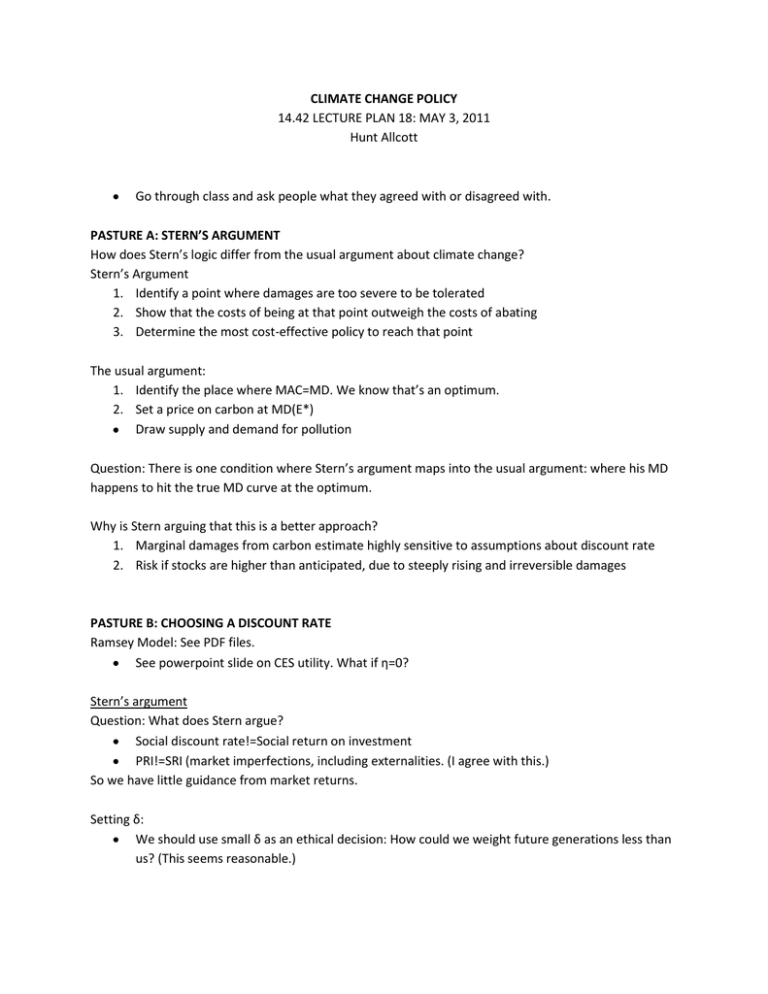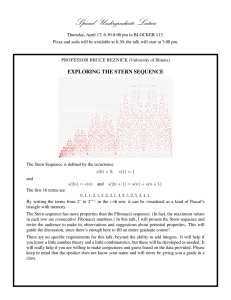CLIMATE CHANGE POLICY 14.42 LECTURE PLAN 18: MAY 3, 2011 Hunt Allcott
advertisement

CLIMATE CHANGE POLICY 14.42 LECTURE PLAN 18: MAY 3, 2011 Hunt Allcott Go through class and ask people what they agreed with or disagreed with. PASTURE A: STERN’S ARGUMENT How does Stern’s logic differ from the usual argument about climate change? Stern’s Argument 1. Identify a point where damages are too severe to be tolerated 2. Show that the costs of being at that point outweigh the costs of abating 3. Determine the most cost-effective policy to reach that point The usual argument: 1. Identify the place where MAC=MD. We know that’s an optimum. 2. Set a price on carbon at MD(E*) Draw supply and demand for pollution Question: There is one condition where Stern’s argument maps into the usual argument: where his MD happens to hit the true MD curve at the optimum. Why is Stern arguing that this is a better approach? 1. Marginal damages from carbon estimate highly sensitive to assumptions about discount rate 2. Risk if stocks are higher than anticipated, due to steeply rising and irreversible damages PASTURE B: CHOOSING A DISCOUNT RATE Ramsey Model: See PDF files. See powerpoint slide on CES utility. What if η=0? Stern’s argument Question: What does Stern argue? Social discount rate!=Social return on investment PRI!=SRI (market imperfections, including externalities. (I agree with this.) So we have little guidance from market returns. Setting δ: We should use small δ as an ethical decision: How could we weight future generations less than us? (This seems reasonable.) Use δ=0.1 to account for possibility of mass extinction (!). (I think that this is a pretty loose argument) Setting η: Notice that η influences intratemporal allocations, intertemporal allocations, and risk attitudes Use data on income redistribution in democratic countries. Ppt slide. o Η>2 is “unacceptably egalitarian.” Stern uses: o g=1.3% o δ=0.1% o η=1 Weitzman’s Trio of Twos g=2% η=2% (from other empirical work δ=2% (backed out: must be true because r=6%). Use people’s actual decisions, don’t be paternalistic! The importance of discounting Ppt slides on Nordhaus and Weitzman Discount rate adjusting for growth = 1.4%-1.3% =0.1% Present value in 2200=.001C+.001C(1.013)/1.014+.001C(1.013)2/1.0142+…=.001C/.001 Then discount to the present. 0.001C/(0.001) * (1.001)-189=82% of current consumption Intertemporal Pareto Optimality Question: Why don’t we invest in capital markets now, earn those returns, and then use that money to abate the carbon problem later? Put differently: We are going to leave a stock of capital to our children. Should we invest in the market or invest in carbon abatement? Answer 1: One has a return of 6%, the other has a return that is less. Answer 2: We might think that these investments have PRI>SRI because of market failures. Thomas Schelling: Don’t we have other social investments with high returns? Invest in poor countries to increase standard of living. Risk adjustment Capital asset pricing model gives interest rate as a function of correlation Ri=Rf+β(E[Rm]-Rf) Β=cov(Ri,Rm)/var(Rm) Rf we can agree is around 1.5% Rm has been around 6%. Question: What is β? What’s the correlation between climate damages and the level of GDP? Models often assume a percent of GDP. So should use Rm. But think through what’s affected: outdoor ecosystems, agriculture, etc. This as a percentage of GDP is not necessarily constant over time. Not highly correlated with growth driven by tech progress in computers, pharmaceuticals, etc. PASTURE 4: FAT TAILS Ppt slide: Weitzman’s fat tails PASTURE 5: POLICY MECHANISMS Question: So what should we do from a policy perspective? Carbon prices Question: Are taxes vs. quantities preferred? Weitzman argument Stern argues that MD is very steeply sloped at 550ppm, so we should want quantity restrictions Abatement Path Question: Should we abate a lot now or abate a lot later? Answer 1: Climate policy ramp (Nordhaus, Stavins): Make other high-return investments now until the damages from carbon are higher, then use our larger capital stock to abate later. Answer 2: Convex abatement costs (Stern). It’s cheaper to abate a similar amount over time than to try to abate all at one. Technology subsidies? Question: Should the government subsidize technological innovation? Answer 1: If there is no carbon price, this could be a second best. Answer 2: If there are innovation market failures, this could be a first best. Basic research is high risk, high return, and the market is risk averse Basic research has spillovers that are not fully appropriated by the researchers. But you might be worried that government R&D isn’t as efficient. So we trade off the magnitude of the market failures with the magnitude of the inefficiency in government R&D. PASTURE 6: OTHER ISSUES Assessing Damages What if preferences change? Schelling’s mud example. Tropical disease and disasters: tropical countries will be much better prepared because they will be richer. MIT OpenCourseWare http://ocw.mit.edu 14.42 / 14.420 Environmental Policy and Economics Spring 2011 For information about citing these materials or our Terms of Use, visit: http://ocw.mit.edu/terms.




